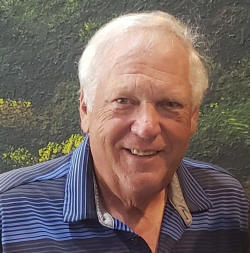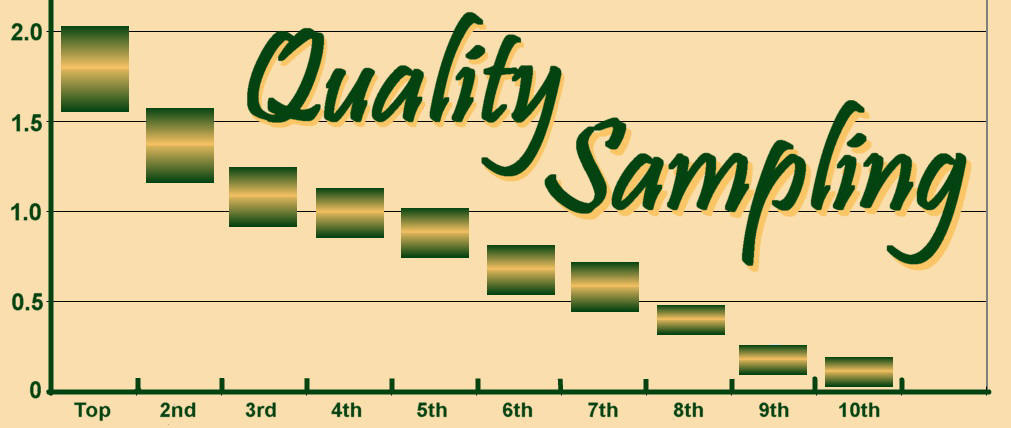|
SNAPSHOT:
 Born: Born:
May 26, 1950, Hartford, Connecticut.
Married:
Karen Ronne Tupek
Education:
Graduated: Manchester High School, Manchester,
CT. June 1968
Graduated: University of New Hampshire, June
1972, B.S. in Mathematics
Graduated: University of Connecticut, June
1974, .M.S. in Statistics
Career:
Arbitron (now part of Nielsen)
Census Bureau
National Science Foundation
Bureau of Labor Statistics
(see details, below)
Hobbies:
Skiing, Tennis, Golf, Bridge
Interests:
Travel
Member:
American Statistical Association (Fellow)
The
Corinthians (boating club in Lighthouse Point, Florida (Commodore,
2017-18)
Al's
Professional Career

Fellow of the American
Statistical Association
Mr.
Tupek is recognized in the statistical community for developing and
implementing innovative application of statistics, survey methods, and
technology to improve statistical products. He has over 40 years of
experience in designing surveys and managing statistical programs at
Arbitron, Inc./Nielsen Audio (2006 - 2014), the US Census Bureau
(1998-2006) and 1974-1979), the National Science Foundation (1992-1998),
and the Bureau of Labor Statistics (1979-1992). While at BLS, he was the
agency coordinator for the interagency effort to implement a multi-year
research effort to improve the efficiency and cost-effectiveness of the
Current Population Survey through automation of data collection, sample
redesign, and improved data processing. In the 1980s, he pioneered work
on the use of touch-tone data entry for collecting monthly data from over
300,000 businesses for the Payroll Employment Survey. He championed
efforts to develop small area modeling methods for labor force, poverty,
and health insurance coverage measures. Mr. Tupek led the effort to
automate the sampling frame development for the nation’s major household
survey and the testing and development of the American Community Survey
that has been acclaimed as the Census Bureau’s most important innovation
in the last 50 years. At Arbitron/Nielsen Audio, Mr. Tupek set criteria
for market sample sizes to help with client expectations and negotiations,
led research on model-based estimation and more efficient sampling methods
to improve the quality of radio ratings without increasing cost, and
provided clients with analyses on the impact of methodological change
during Arbitron's transition from paper diary methods to electronic meter
measurement of radio listening.
Mr. Tupek was a member of the Federal
Committee on Statistical Methodology from 1992-2006 and was chosen by the
Chief Statistician of the Office of Management and Budget and the
directors of the fourteen largest statistical agencies to chair the Task
Force on One-stop Shopping for Federal Statistics that led to the
development of the FEDStats website in 1996. Mr. Tupek also led an
interagency effort to develop quality standards for federal surveys that
were issued by the Office and Management and Budget in 2006.
Mr. Tupek has held several positions in
and is a fellow of the American Statistical Association. He is currently
on the Excellence in Statistical Reporting Award Committee. He served for
six years on the Committee of Representatives to the American Association
for the Advancement of Science. He was a member of the Committee on
Committees (COC) that helped reorganize the ASA committee structure,
including the elimination of the COC. As Publications Officer of the
Survey Research Methods Section, he led efforts to provide online access
to the Section’s historical proceedings from the annual meetings. As a
member of the ASA Career Development Committee, he started and wrote the
first article for “Career Corners” that is now a regular feature in Amstat
News.
Chief Statistical
Officer, Arbitron Inc., later Nielsen Audio (2006 - 2014)
Mr. Tupek joined Arbitron as it was about to transition from paper and
pencil diary methods to the use of an electronic meter to measure radio
listening and provide radio station ratings in the top 50 U.S.
metropolitan areas. The challenges in gaining the acceptance of
customers, who use the ratings to sell advertising and determine
programming changes, were enormous. Mr. Tupek was essential part of the
management team effort to stem the tide of lawsuits, Congressional
hearings, threats of federal oversite by the FCC and other federal and
state agencies. In April 2010, after two years of legal challenges,
Arbitron announced a settlement with opponents of the new methods. Mr.
Tupek was part of the negotiating team, and helped redesign the survey
methods, including the selective use of in-person recruitment of
households, that led to the agreement. Mr. Tupek has worked closely with
the Media Rating Council, that accredits media rating companies,
Arbitron's advisory councils, and other clients to help improve Arbitron's
statistical and survey methods to better meet client needs and industry
standards. He oversees a small group of statisticians and demographers as
well as external statistical consultants to help measure and understand
all components of survey error and improve the statistical and survey
methods used by Arbitron for media measurement. He established sample
design guidance and standards for Arbitron's custom business as well as
its syndicated services. He led projects to research alternative
model-based estimation methods and sampling strategies that take advantage
of household characteristics on vendor frames to significantly improve the
quality of radio ratings without increasing cost to our clients. Under
Mr. Tupek's direction, Arbitron released improved standard error and
confidence intervals methods that are much more easy for clients to use.
Mr. Tupek is the spokesperson for explaining the application of new
methods and his team is often called upon to develop methods that address
client concerns.
Chief, Demographic
Statistical Methods Division, US Census Bureau (1998-2006)
Mr. Tupek was responsible for developing effective statistical
methodologies for household surveys that provide the nation's vital
demographic data, including the unemployment rate, poverty rate, crime
rate, and the consumer price index. Mr. Tupek provided leadership in the
development of methodologies for the American Community Survey that the
Census Bureau implemented in 2005 as a replacement for the decennial
census long form. He directed the coordinated sample redesign for the
major national household surveys. He led the effort to develop an
automated mapping and address listing process that is intended to provide
a continuously updated address list for all Census Bureau household
surveys. Mr. Tupek supervised approximately 170 persons, including about
100 mathematical statisticians, 40 computer specialists and support
personnel. Mr. Tupek and his staff worked closely with staff in over 10
other federal agencies that sponsor more than 30 surveys and other
projects conducted by the Census Bureau. Mr. Tupek was also responsible
for leading the development of methods using new data sources to provide
information on the recovery from Hurricane Katrina. The Chief,
Demographic Statistical Methods Division is a Senior Executive Service
(SES) position.
Chair, Methodology and Standards Council (2004 – 2006)
After rejoining the Census Bureau in 1998, Mr. Tupek was a member of the
Census Bureau's Methodology and Standards Council that developed a
corporate hiring and career enhancement program for mathematical
statisticians and a quality framework for statistical principles,
standards, guidelines, and best practices. Mr. Tupek also chaired the
Methodology and Standards Council in his last two years at the Census
Bureau. He led an effort to assess and improve the Census Bureau’s
adherence to current quality standards. Mr. Tupek was responsible for the
hiring and development of all mathematical statisticians at the Census
Bureau that includes a mentoring program and a rotation program. Mr.
Tupek also led an interagency effort to develop new quality standards for
all federal surveys. The Office and Management and Budget issued and
implemented these standards in October 2006.
Acting Associate Director for Demographic Programs, US Census Bureau
(2005) and Chief, Data Development Division (2006)
For six months, Mr. Tupek directed a professional staff of over 700 people
to provide the nation’s vital information on its people and housing. He
provided the leadership for conducting dozens of household surveys, with
over $200 million of annual funding from other federal agencies. Mr.
Tupek maintained a strong leadership team in the Directorate while all
four division chief jobs were vacant. He was also instrumental in forming
a new division to handle the Census Bureau's highly confidential
administrative data programs and led that division during it's formative
year.
Deputy Director,
Division of Science Resources Studies (now National Center for Science and
Engineering Statistics), National Science Foundation (1992-1998)
With the Division Director, Mr. Tupek managed a federal statistical agency
that provides data and analyses about the nation’s science and engineering
enterprise. He directed surveys, research projects, and studies to
measure factors related to science, engineering, and technology (SE&T)
education, work force, outputs, impacts, partnerships, and linkages. Mr.
Tupek led the design and development of electronic dissemination of
information produced by the Division, including easy access to all
Division reports via the Internet and the development of several databases
to allow researchers at NSF and elsewhere to produce customized
tabulations and analyses of micro (respondent-level) data. While at NSF,
he also led the interagency effort to provide easy access to all federal
statistics through one portal, FEDSTATS. The Division supports 13 annual
and biennial surveys and has a budget of approximately $16 million
including a staff of 45 managerial, professional, administrative, and
support staff. The Deputy Director, Division of Science Resources Studies
is a Senior Executive Service (SES) position.
Chief, Statistical
Methods Division, Office of Employment and Unemployment Statistics; Bureau
of Labor Statistics (1987-1992)
Mr. Tupek led the development and testing of new survey methodology for
employment and unemployment statistics programs at the BLS. His
accomplishments include planning, developing, and directing the
implementation of a multi-year research effort, in cooperation with the
Bureau of the Census, to improve the Current Population Survey (CPS).
This effort included the automation of data collection, development of a
new questionnaire, redesign of the sample, development of a shared BLS/Census
processing system, and improvement of the longitudinal data in the CPS.
While at BLS, he championed the introduction of Total Quality Management
in the employment and unemployment statistics programs of the BLS. Serving
as administrator and advisor to the Office’s Quality Council. He also
pioneered the use of touch-tone recognition technology for the BLS payroll
employment survey and the use of new measurement methodologies to assess
the mode effect. He directed a high quality staff of 29 persons (7 PhDs,
14 with masters degrees), including mathematical statisticians,
psychologists, sociologists, anthropologists, econometricians, computer
specialists, and support staff.
Supervisory Mathematical Statistician, Bureau of Labor Statistics
(1979-1987)
Mr. Tupek managed the development and testing of research projects for the
Current Employment Statistics modernization and other programs. He managed
the development and testing of CATI and the use of Response Analysis
Surveys in the Current Employment Statistics Program and directed the
business birth research projects and evaluating approaches to maintain a
current sampling frame and reduce the dependency of bias adjustment
factors in the payroll employment survey. He directed a staff of 3-6
mathematical statisticians, 1 secretary, and 1 or 2 contract programmers.
Mathematical
Statistician, Economic Surveys Division, U.S. Census Bureau (1974-1979)
In his first professional job, Mr. Tupek developed sample designs,
estimation procedures, edit and imputation procedures, and quality control
plans for several national business establishment surveys and the Economic
Censuses. He designed and implemented an automated recordkeeping system
for the quality control operations. He was the most junior person to
serve as a project leader for an evaluation project of the 1977 Economic
Censuses.
University of Connecticut
M.S. Statistics
1974
University of New Hampshire
B.S. Mathematics 1972
Additional
graduate-level training taken at George Washington University, American
University, and Office of Personal Management Executive Training Centers.
Publications and Awards
Significant Publications and Professional Activities
Co-author of “Recommendations for Revising Standards for Statistical
Surveys for U. S. Federal Agencies” for 2004 European Conference on
Quality of Official Statistics.
Author of “Combining Years of Data from a Rolling Sample Survey,” an
Invited Paper for the 2003 Meetings of the International Statistical
Institute.
Co-author of chapter 5, Bureau of Labor Statistics’ State and Local Area
Estimates of Employment and Unemployment, Indirect Estimators in U.S.
Federal Programs, Lecture Notes in Statistics, 1996, Springer-Verlag,
New York, Inc.
Chair and Co-Author of Statistical Policy Working Paper 24, Electronic
Dissemination of Statistical Data, November 1995, Office of Management
and Budget
Co-Author of Measurement Error in Touch-tone Self-Response Applications
to Establishment Surveys, Survey Methodology Journal, 1992, Statistics
Canada
Co-Author of CATI
and Touch-tone Self-Response Applications for Establishment Surveys, Vol.
4, No. 4, 1988, Journal of Official Statistics, Statistics Sweden
Co-Author of
Statistical Policy Working Paper 16, Quality of Establishment Surveys,
1987, Office of Management and Budget
Served as discussant
and panelist for several sessions of the Federal Committee on Statistical
Methodology Research and Policy Conferences and at the Joint Statistical
Meetings
Author, or co-author
of numerous papers at the annual meetings of the American Statistical
Association and meetings sponsored by the Federal Committee on Statistical
Methodology
Organizer for
several sessions at the Joint Statistical Meetings and the Federal
Committee on Statistical Methodology Research Conferences including a
session on performance measures in statistical agencies and technological
applications to surveys.
Referee for papers
in the Journal of Official Statistics, published by Statistics Sweden, and
the Survey Methodology Journal, published by Statistics Canada
Major Awards
Arbitron
Determination-Commitment Success Team that reached a settlement agreement
with Congressman Towns and the PPM Coalition that had opposed
implementation of electronic meter measurement (2010)
Elected Fellow of
the American Statistical Association in 2003
National Partnership
for Reinventing Government Hammer Award for FedStats, 2000
National Partnership
for Reinventing Government Hammer Award for the American Community Survey,
1999
Ford Foundation and
John F. Kennedy School of Government Award for Innovations in American
Government for Touchtone Data Entry and Voice Recognition in Reengineering
Establishment Survey Data Collection, 1995
Secretary of Labor’s
Exceptional Achievement award for Developing Automated Collection
Techniques for the Current Employment Statistics Survey, 1988

Quality
Sampling LLC
Alan R.
Tupek
Statistical Consultant
240-277-2370
alan.tupek@gmail.com
atupek@aol.com
6806 Newport Lake
Circle
Boca Raton, Florida
33496
Directs
the development of innovative application of statistics, survey methods,
and technology to improve statistical products.
These
include --
-
Sample frame
development
-
Sampling methods
-
Methods to control
and measure nonresponse
-
Methods to improve
population coverage
-
Measurement error
methods
-
Estimation and
weighting methods
-
Variance estimation
methods
Applications include --
-
Official statistics
of federal, state, and local governments
-
Media audience
measurement
Innovations include—
-
Transitions to
automated survey methods
-
Indirect or
model-based estimation methods
-
Survey quality
standards
-
Dissemination of
survey quality information
|